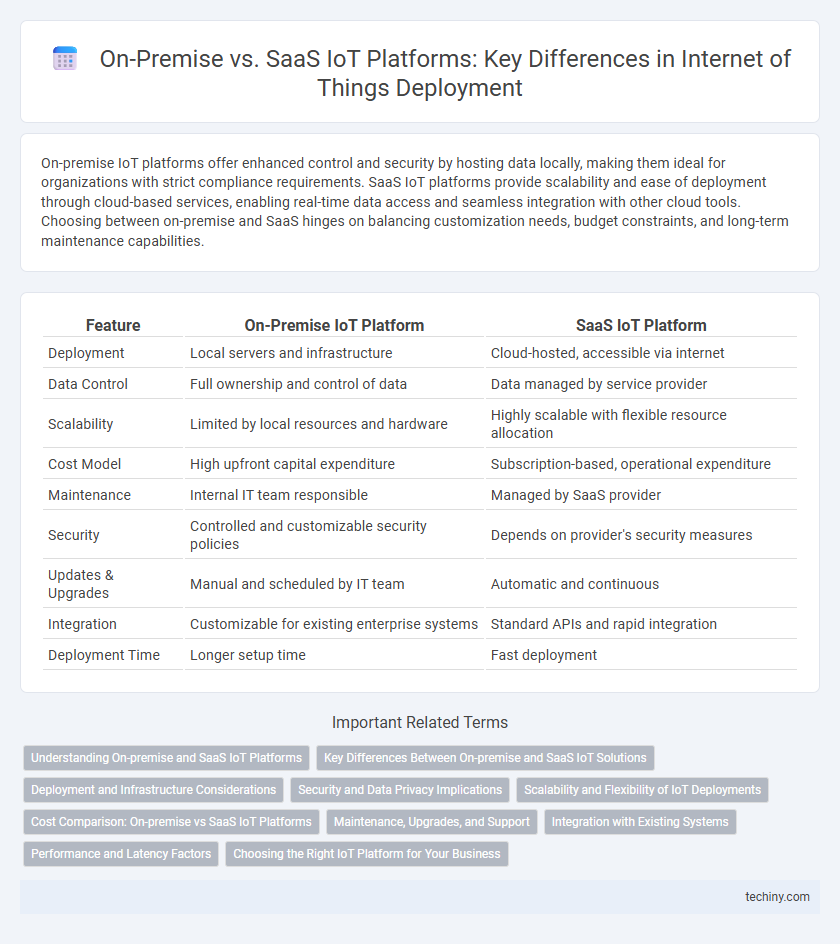On-premise IoT platforms offer enhanced control and security by hosting data locally, making them ideal for organizations with strict compliance requirements. SaaS IoT platforms provide scalability and ease of deployment through cloud-based services, enabling real-time data access and seamless integration with other cloud tools. Choosing between on-premise and SaaS hinges on balancing customization needs, budget constraints, and long-term maintenance capabilities.
Table of Comparison
| Feature | On-Premise IoT Platform | SaaS IoT Platform |
|---|---|---|
| Deployment | Local servers and infrastructure | Cloud-hosted, accessible via internet |
| Data Control | Full ownership and control of data | Data managed by service provider |
| Scalability | Limited by local resources and hardware | Highly scalable with flexible resource allocation |
| Cost Model | High upfront capital expenditure | Subscription-based, operational expenditure |
| Maintenance | Internal IT team responsible | Managed by SaaS provider |
| Security | Controlled and customizable security policies | Depends on provider's security measures |
| Updates & Upgrades | Manual and scheduled by IT team | Automatic and continuous |
| Integration | Customizable for existing enterprise systems | Standard APIs and rapid integration |
| Deployment Time | Longer setup time | Fast deployment |
Understanding On-premise and SaaS IoT Platforms
On-premise IoT platforms offer organizations complete control over their data and infrastructure by hosting solutions locally, enhancing security and customization capabilities. SaaS IoT platforms provide scalable, cloud-based services with reduced upfront costs and simplified maintenance, enabling rapid deployment and easier integration across diverse devices. Choosing between on-premise and SaaS depends on factors like data sensitivity, budget constraints, and desired scalability for IoT deployments.
Key Differences Between On-premise and SaaS IoT Solutions
On-premise IoT platforms offer complete control over data security, customization, and infrastructure management, making them ideal for industries with strict regulatory requirements. SaaS IoT solutions provide scalability, seamless updates, and reduced upfront costs by leveraging cloud infrastructure and subscription-based models. The key differences lie in deployment, maintenance responsibilities, cost structures, and flexibility in integrating with existing enterprise systems.
Deployment and Infrastructure Considerations
On-premise IoT platforms require deploying dedicated hardware and software within an organization's local network, offering greater control over data security and customization but demanding significant capital investment and IT resources. SaaS IoT platforms leverage cloud infrastructure, enabling rapid deployment, scalability, and reduced maintenance efforts while relying on third-party providers for data storage and platform management. Infrastructure considerations include evaluating network bandwidth, latency requirements, compliance with data residency regulations, and integration capabilities with existing enterprise systems.
Security and Data Privacy Implications
On-premise IoT platforms offer greater control over security protocols and data storage, enabling organizations to implement customized measures tailored to their specific privacy requirements. SaaS IoT platforms provide simplified management and automatic updates but require trusted third-party providers to ensure data encryption, compliance with standards like GDPR, and protection against unauthorized access. Evaluating the security architecture and data governance policies of each platform is critical for mitigating risks in connected device ecosystems.
Scalability and Flexibility of IoT Deployments
On-premise IoT platforms offer limited scalability due to hardware constraints and require significant upfront investment, while SaaS IoT platforms provide dynamic scalability by leveraging cloud infrastructure to handle fluctuating device data volumes. SaaS platforms enable rapid deployment and flexible integration with third-party applications, supporting diverse IoT use cases and real-time data processing. Enterprises benefit from SaaS solutions' ability to adapt to changing requirements without extensive IT overhead, enhancing operational agility in IoT deployments.
Cost Comparison: On-premise vs SaaS IoT Platforms
On-premise IoT platforms require substantial initial capital expenditure for hardware, software licenses, and infrastructure setup, while ongoing costs include maintenance, upgrades, and IT personnel. SaaS IoT platforms operate on a subscription-based pricing model with predictable operational expenses, eliminating the need for large upfront investments and reducing maintenance overhead. Total cost of ownership for SaaS solutions is often lower for small to medium enterprises, whereas large organizations with extensive customization needs may find on-premise deployments more cost-effective in the long term.
Maintenance, Upgrades, and Support
On-premise IoT platforms require in-house teams for maintenance, regular software updates, and hardware management, increasing operational complexity and costs. SaaS IoT platforms offer automated upgrades, proactive support, and scalable maintenance handled by the provider, enhancing system reliability and reducing downtime. Efficient support services in SaaS models ensure faster issue resolution through centralized monitoring and expert intervention, optimizing overall IoT performance.
Integration with Existing Systems
On-premise IoT platforms offer deeper integration with existing legacy systems and IT infrastructure, enabling organizations to maintain full control over data flow and security protocols. SaaS IoT platforms provide faster deployment and seamless integration through standardized APIs and cloud-based middleware, facilitating interoperability with modern enterprise applications and third-party services. Evaluating the complexity of current infrastructure and the need for customization is critical when selecting between on-premise and SaaS solutions for IoT integration.
Performance and Latency Factors
On-premise IoT platforms offer lower latency and higher performance by processing data locally, minimizing dependence on external networks and reducing transmission delays critical for real-time applications like industrial automation. SaaS IoT platforms rely on cloud infrastructure, which can introduce latency due to data traveling between devices and remote servers, potentially impacting time-sensitive operations. Network bandwidth, proximity to data centers, and edge computing capabilities significantly influence the performance and latency differences between on-premise and SaaS IoT solutions.
Choosing the Right IoT Platform for Your Business
Choosing the right IoT platform for your business depends on factors like control, scalability, and cost. On-premise IoT platforms offer greater data security and customization, ideal for industries with strict compliance requirements, while SaaS IoT platforms provide flexible deployment, automatic updates, and reduced infrastructure costs. Businesses must evaluate their technical resources and long-term growth plans to select between on-premise control and SaaS convenience, ensuring optimal IoT integration and ROI.
On-premise vs SaaS IoT platforms Infographic

 techiny.com
techiny.com